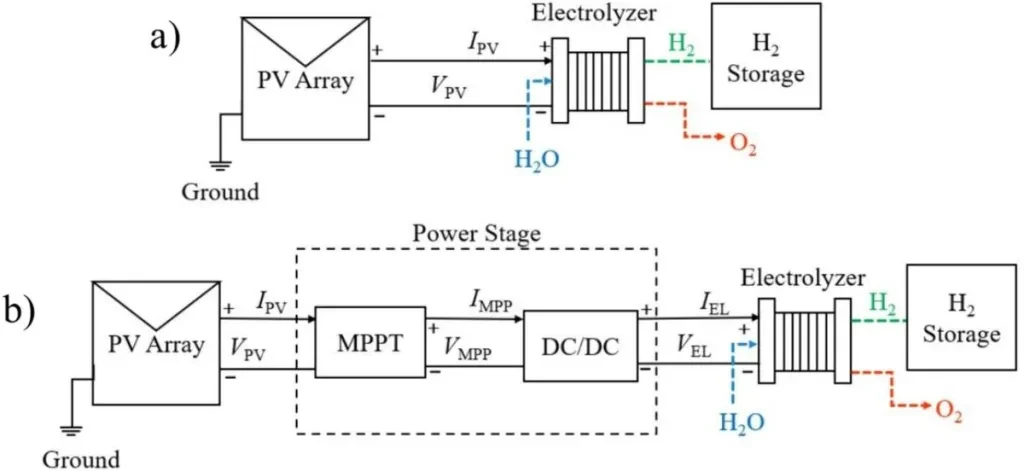Researchers in Spain have made a comparative analysis of annual PV-powered hydrogen production for direct and indirect configurations and have found that indirect systems not only produce more hydrogen but also that they show higher resilience to module power losses.

Schematics of the direct coupling configuration (a) and the indirect coupling configuration (b)
Image: Universidad Politécnica de Madrid, Energy Conversion and Management, CC BY 4.0
Scientists from Spain’s Technical University of Madrid have conducted a comparative study of direct and indirect coupling configurations for PV and electrolyzers in the production of green hydrogen (H2). The study was based on numerical simulations performed on the software MATLAB, with weather conditions based on a typical meteorological year in Madrid.
PV-powered hydrogen systems in which the electrolyzer input is connected to the electrical output of the PV generator without an intermediate power stage are often referred to as having a direct coupling configuration. Systems with indirect configuration, by contrast, incorporate electronics to bias the PV generator at its maximum power and use maximum power point tracking (MPPT) ensuring the maximization of PV power generation as meteorological conditions vary, with a DC-DC converter matching the output power provided by the MPPT to the input power of the electrolyzer.
“The indirect configuration involves a power stage (PS) with a maximum power point tracker and a DC-DC converter, maintaining an optimal power transfer from PV to electrolyzers but incurs losses at the PS. The direct configuration avoids these losses but requires a specific design of the PV generator to achieve high electrical transfer,” the scientists said, referring to the main advantages and disadvantages of each configuration.
“In defense of direct coupling, several authors state that this configuration could be sufficiently good to have the electrolyzer working near the MPP if the PV array and electrolyzer are correctly designed; others declare that direct coupling configuration is economically advantageous, since the costs of electronic coupling systems are entirely avoided.”
The research group conducted a series of simulations on an experimental setup consisting of a 100 W solar module and a proton exchange membrane (PEM) electrolyzer with a maximum current density of 4 A-cm2. In the case of the indirect system, the DC-DC converter efficiency is assumed to be 95%, while in the case of the direct system, the number of solar cells connected in series and cell area were optimized while preserving the power of the PV module for a fair comparison.
“The presence of the MPPT makes the PV module operate at its MPPT for all meteorological conditions, unlike the direct coupling configuration, that only works near MPPT for a scarce range of global irradiance and temperature, even when its number of cells has been optimized,” explained the group.
“This higher PV power translates also into an increased amount of electric power transferred to the electrolyzer and, therefore, into a larger H2 production.”
Through this analysis, the scientists found that, thanks to the PS, the indirect coupling configuration may inject 223 kWh per year of electric energy, which is 39.4% more than the direct configuration, into the electrolyzer. This would be enough to produce 5.79 kg of H2 in a year, which would be 37.5% more than the amount produced in the direct coupling system.
The direct system was also found to achieve an energy efficiency of 5%, while the indirect one showed an efficiency of 6.9%.
In addition, the scientists also assessed which system is more resilient to module power losses. If it had lost one of the 20 cells in the PV module, the direct system would lose 18.3% of its H2 production, while the indirect would only lose 5%. At a loss of seven cells, the direct system will stop producing any H2, while the indirect will still produce it, albeit at a 37% lower capacity.
Furthermore, the academics found that only when the DC-DC converter efficiency drops to below 73% will it produce less H2 than the direct coupled system. “For a DC-DC converter design to be considered valid, its efficiency must exceed 90%, so a scenario with efficiencies and H2 production as low as in the direct coupling is unlikely to take place,” the researchers emphasized.
Their findings can be found in the study “Optimizing hydrogen Production: A comparative study of direct and indirect coupling between photovoltaics and electrolyzer,” published in Energy Conversion and Management.
This content is protected by copyright and may not be reused. If you want to cooperate with us and would like to reuse some of our content, please contact: editors@pv-magazine.com.
Source from pv magazine
Disclaimer: The information set forth above is provided by pv-magazine.com independently of Alibaba.com. Alibaba.com makes no representation and warranties as to the quality and reliability of the seller and products. Alibaba.com expressly disclaims any liability for breaches pertaining to the copyright of content.



